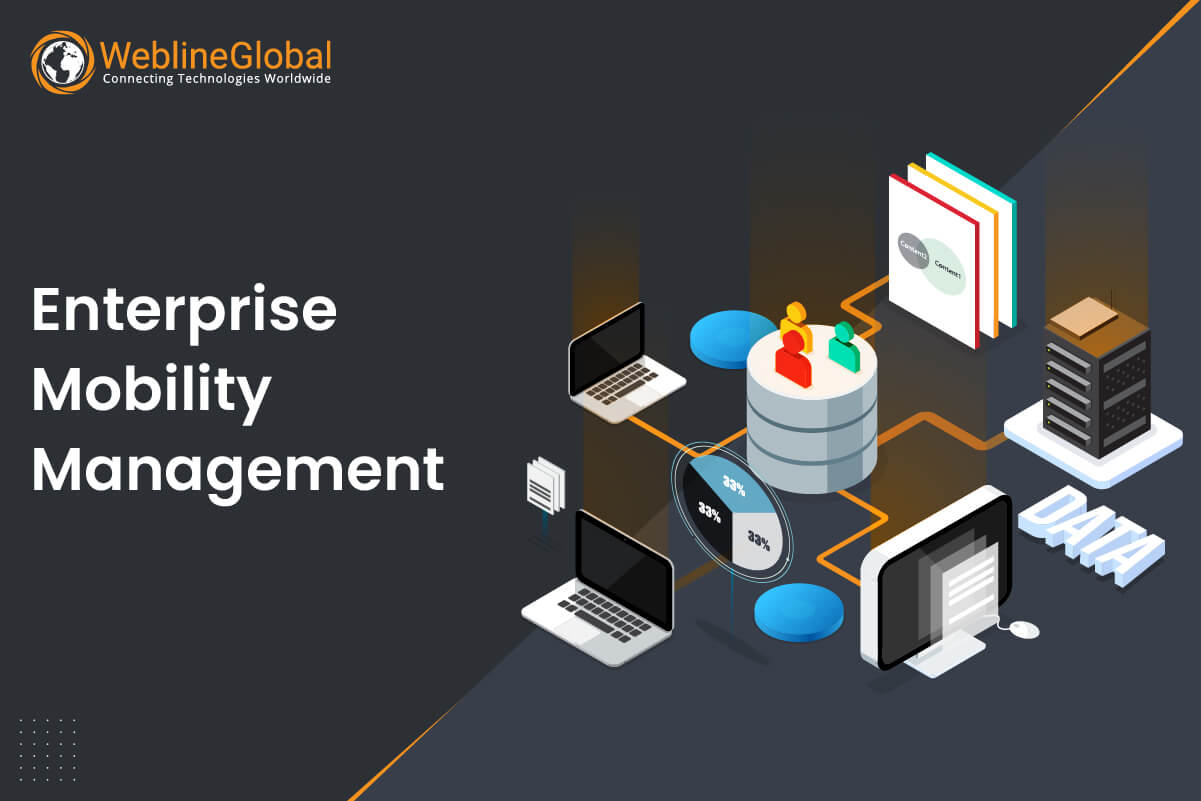
With enormous data storage and exchange, more and more modernization of devices takes place. With such modernization, the challenges to keep the company’s and customers’ information safe and secure emerge, and corporate companies spend billions of dollars to achieve it. Enterprise mobility management has been constantly evolving to adapt to an immensely changing set of device platforms and trends in mobility at the workplace.
In this short guide, we will look at what enterprise mobility management is and why enterprise mobility management is essential to all businesses with cogent reasons and solutions along with popular enterprise mobility glossary terms or components to consider while building a roadmap for your futuristic mobility.
What is Enterprise Mobility Management?
What is enterprise mobility management? The simplest answer to this question is that it is the way to secure data or information on mobile devices. Now, these devices could be company-owned or employee-owned (employees bringing them to their workplaces).
Enterprise mobility management solutions, popularly known as EMM solutions, ideally include a broad suite of services or actions engineered to keep the company’s intellectual properties and customer’s data such as PII (Personal Identifiable Information) without hampering other business operations and functionalities.
The purpose of managing enterprise mobility is not only to secure remote devices but also to provide employees with IT support to function smoothly in the interest of the organization and its goal. Along with managing device-level access, EMM assists IT administrators in controlling all devices, applications, roles/privileges, locations, and other stuff through customized software solutions.
Why is Enterprise Mobility Management essential to businesses?
According to research giant Statista, during the fourth quarter of 2023, the number of data breaches exposed more than 8 million records all over the world.
Furthermore, on the same page, the report says that data breach incidents have shown terrible consequences, with financial losses and business disruption being the most common impacts.
As of 2023, the average data breach cost across all enterprises all over the world was 4.45 million U.S. dollars. Additionally, the United States alone bore the highest average breach cost globally, just under US $10 million.
With such alarming statistics, enterprises all over the world have started putting more and more funds into securing their and their clients’ data. Industries and sectors such as national defense, healthcare, and finance/banking have been extra cautious in managing their enterprise mobility systems. Small, mid-sized, and large enterprises need to adopt the latest in Enterprise Mobility Management to grow in their sectors and win their stakeholders’ trust.
What are the top benefits of Enterprise Mobility Management to businesses?
EMM offers several benefits to enterprises with mobile devices at their workstations. Organizations that want a smooth and secure flow of information and data across their stakeholders such as authorities, clients, and administrators would highly benefit from enterprise mobility management solutions. Here are the top benefits of Enterprise Mobility Management:
Improved security
The primary benefit of Enterprise Mobility Management solutions (EMM solutions) is to provide enhanced security. You certainly fasten your seatbelt with EMM solutions for your organization. Make sure that your proprietary data on company devices and other essential information of your client, stakeholders, or customers is safer yet functional.
Data protection/security
For any enterprise, it is essential to segment personal information from corporate data on all devices in the network with the help of centralization. Data protection and security can be enhanced using Enterprise Mobility Management solutions because companies deal with personal and professional datasets of employees and clients.
More flexibility/choices
EMM tools help users access corporate resources and applications securely through Enterprise Mobility solutions which help them enhance their productivity yet remain in a controlled environment.
Assured GRC (Governance, Risk, and Compliance)
EMM solutions can be customized as per certain policies and sets of rules that your organization runs on. That said, EMM can provide tools to monitor and report devices in the ecosystem when they violate any security policy or regulatory requirement. Ultimately, enterprises can maintain industry standards and stay away from heavy penalties.
Troubleshooting and remote support
Enterprise Mobility Management software tools serve as solutions to service desks and support teams as they can provide remote support to their employees and other stakeholders. It is possible to remotely manage and provide IT/technical support for end-users devices using enterprise mobility solutions. This saves resources, time, and commuting to the workplace.
Leaner app management
Enterprises need to keep their mobile devices in the network latest and updated. With EMM solutions in place, organizations can have all operations through mobility on the same line and goal. That said, enterprises can distribute, update, and manage their mobile devices efficiently and securely.
Cost saving
Enterprise mobility solutions development can help save loads of money for enterprises as they can integrate BYOD (bring your device) policies that allow their employees to bring devices and work on premises in a controlled environment. The other option is to provide hardware and software support at workers’ places, saving a lot of infrastructural and overhead costs for the organization.
What are the main components or glossary of Enterprise Mobility Management?
Enterprise Mobility Management or EMM is an umbrella term that includes several components under it. These components combine multifaceted devices and policies to execute a secure and controlled environment for desired productivity and outcome. EMM can control the connection among various mobile devices and infrastructures of the organization. As technology evolves, more and more advanced solutions take place: you may go through a comprehensive guide on Enterprise Mobility Strategies in 2024 to build a roadmap ahead considering various components. Here are some of the glossary terms or components for EMM to consider:
Mobile Device Management (MDM)
In this, device management is carried out to perform several actions to manage all devices for security. The organization may set features, apps, and content rating restrictions and enforce passwords/encryption on the machines. Also, enterprise mobility management helps organizations locate and lock devices as well as perform selected wiping of corporate data without touching any personal data.
Mobile Content Management (MCM)
For enterprises that deal with enormous amounts of content such as files, inventory, or stock, it is essential to have MCM i.e., Mobile Content Management solutions to handle catalogs of business documentation to simplify actions. Also, it is possible to create, edit, and store content in an encrypted way to keep it secure and exercise control over various policies to prevent data leakage.
Mobile Application Management (MAM)
Mobile application management is all about using software and devices in a particular environment. Enterprises can lock the apps and refine their usage as and when required. By deploying customized mobile application management, enterprises can use a unified catalog and streamline their endpoints and mobile apps while managing the lifecycle of apps as they can distribute, update, manage, and protect the data. They can also access the corporate intranet without using a VPN session at the device level which, in turn, reduces the overall costs and assures enhanced security and flawless work process.
Mobile Expense Management (MExM)
The latest enterprise mobility management includes tracking payments and sending payments across devices with security. MExM controls mobile expenses by managing its service plans, purchase workflow, device inventories, and BYOD management. With mobile bill management, enterprises can keep an eye on the financial spending habits of their employees and control them if needed.
Mobile Identity Management (MIM)
Large enterprises need to be vigilant when it comes to enterprise mobility facilities. Hundreds of thousands of people work for corporate giants worldwide and to bring all devices under one mobile enterprise management system is a herculean task. Mobile Identify Management or MIM helps enterprises that only trusted and authenticated users are using corporate apps, and these software tools are utterly secure. Plus, the use of single sign-in can be managed for authentication to access crucial data. By using MIM, it is also possible to use the certifications when the system requires it.
Brace up Yourself with Enterprise Mobility
Enterprise mobility management solutions can help you streamline all your devices and machines under a controlled corporate environment established with sets of rules and regulations. Ask us to build customized enterprise mobility solutions that specifically align with your company’s vision and mission. We offer various engagement models to hire enterprise mobility developers at affordable costs.






